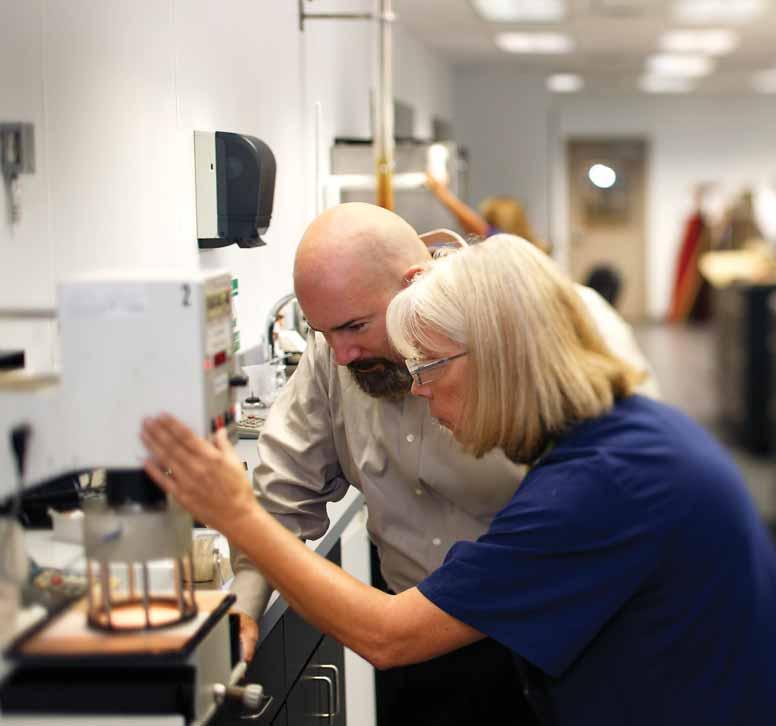
10 minute read
Research and Development
from Raven Issue No. 7
Living in a World of ‘What Ifs’
John Coates and the Glen Raven research and development team that he leads live in a world of “what ifs.” What if we can create a fabric that is more fade resistant? What if we can develop technology to make fabrics more durable and easier to clean? What if we can increase quality and production efficiency?
Advertisement
More than three years ago, Coates, vice president of research and development, posed one of the ultimate questions related to performance fabrics. “What if we could make Sunbrella® fabrics more water repellent without sacrificing breathability?”
For experts in performance fabric development, this question is similar to asking “What if we created a way for people to achieve physical fitness without ever having to exercise?” The issue basically defies conventional wisdom and logic. Fabrics that are highly water repellent, such as vinyl, don’t breathe. Fabrics that breathe, such as cotton, are not water repellent.
Glen Raven, however, has a long history of defying conventionalwisdom through innovation and hard work. The R&D team based at Glen Raven’s Anderson, S.C., plant took on theassignment with some trepidation, but also with confidence that if anyone could do it, it would be this team.
“One of the great advantages we had going into this project is the fact that we are a vertically integrated manufacturer,” Coates said. “We control every aspect of the manufacture of Sunbrella fabrics, beginning with specifications for the polymer chemistry used for fiber formation. We believed that the answer to greater water repellency with no loss of breathability would be found somewhere along the production continuum.”
As a woven product, Sunbrella fabrics have long been known for breathability. Air can pass through the fabrics, which allows for fast drying and helps to discourage the growth of mold and mildew. When it came to water repellency, however, fade resistance and ease of cleaning continue at the same levels in the Next Generation product.
Sunbrella awning and marine fabrics performed well, but there was room for improvement.
Coates’ team began an intense review of every aspect of the production process and determined that the answer was to be found in improvements all along the line. Fiber chemistry was tweaked, yarn preparation adjusted and enhancements made for weaving and finishing.

“Increased production efficiency and improved quality enhance our responsiveness to customer needs,” said Sam Lynn, a leader on the Next Generation research team. “Awning and marine fabricators and their customers will appreciate the full range of improvements in a product that was already considered the industry standard for quality.”
Glen Raven began producing the Next Generation of Sunbrella fabrics earlier this year, and all fabric currently in inventory and distribution represents the improved fabric. Glen Raven chose this approach so it would not obsolete current dealer inventories.
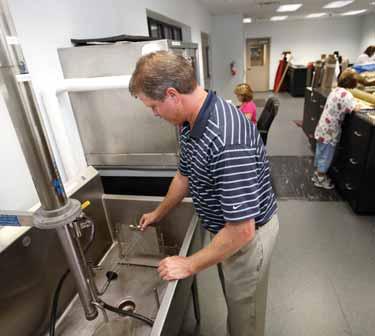
John Coates
“It was not just one thing – no ‘aha’ moment,” Coates said. “Through technical changes at every step of the production process – fiber formation, yarn manufacturing, weaving and finishing – we have created a product that no one thought possible only a few years ago.”
The result of the R&D team’s efforts has been named “Next Generation” of Sunbrella fabrics. The bottom line result is a 25 percent increase in water repellency with no loss of breathability.
“The Next Generation of Sunbrella awning and marine fabrics represents a significant breakthrough,” Coates said. “Historically, it has been extremely difficult, if not impossible, to enhance water repellency in a performance fabric without reducing breathability. After several years of intense development work, we have created a new fabric which shifts this paradigm.”
In addition to increasing water repellency with no loss in breathability, the Next Generation of Sunbrella awning and marine fabrics also offers enhanced quality, greater strength and increased production efficiency. Sunbrella’s legendary
“We have over the past few months noted a decrease in the number of questions from customers related to water repellency,” said Alan Rampey, director of technical services for Glen Raven. “While we subjected Next Generation Sunbrella fabrics to extensive lab testing, it is the experience in the field that really counts. From this initial positive response, we are confident that the new Sunbrella fabrics will result in increased customer satisfaction.”
According to Coates, the new Sunbrella awning and marine fabrics offer the highest performance in the industry.
“We have conducted extensive testing of the Next Generation of Sunbrella fabrics in comparison to our previous offerings and to competitive products,” Coates said. “Our test results show that no other acrylic product on the market today offers the combination of water repellency and breathability of ‘Next Generation’ Sunbrella.”
Glen Raven Anderson, SC, Facility Going ‘Greener’
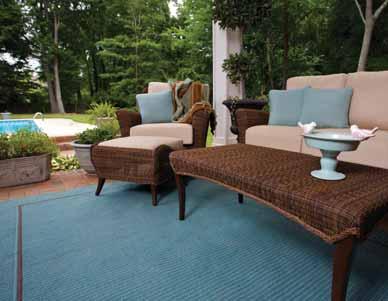
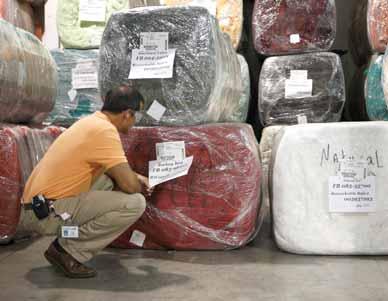
“As we advance best practices in all areas of our operations each year, we also use state-of-the-art approaches to enhance our environmental performance.”
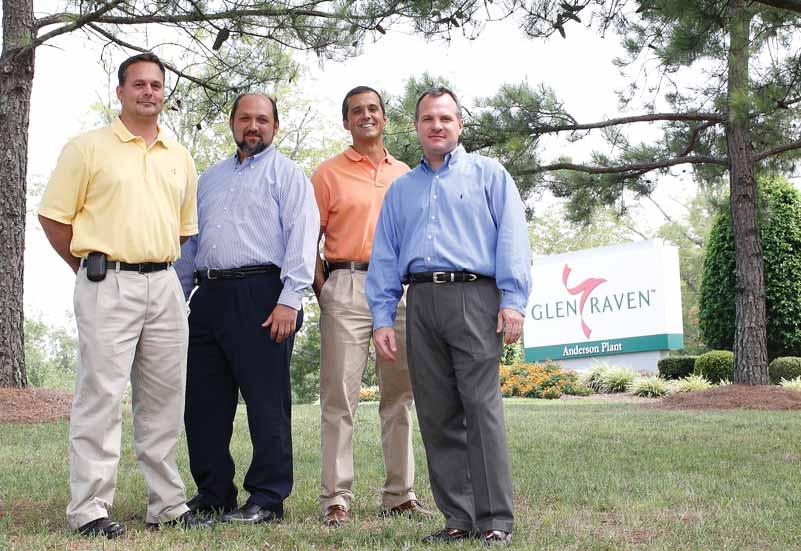
Glen Raven’s Anderson, S.C., facility adopted a “green” focus long before this term worked its way to the top of the environmental lexicon. It began in the early 1990s with planning for an ultra-modern, one-million-squarefoot, vertically integrated facility for Sunbrella® fabrics.
Machine and equipment manufacturers from around the world were invited to present options for the new plant. Energy efficiency was among the top evaluation criteria that Glen Raven engineers used for every choice made for Anderson plant. The goal was to create the most efficient center possible with an environment that would promote product quality and employee health.
From the first days of operation in 1995, the Anderson facility has captured all of its acrylic fabric and fiber waste, a valuable commodity for other applications. Recycling was also a focus for larger items, such as wood palettes, but landfills were still receiving tons of waste from the plant each year.
Early this year, the Anderson plant began a close collaboration with a nearby recycling specialist. The two organizations completed a comprehensive review of the Anderson operation, cataloging various types of waste, setting up systems for collection, reviewing safety instructions and completing detailed cost analysis. A comprehensive recycling program was put into place and the result is zero landfill contributions today.
“Throughout our history, Glen Raven has been committed to environmental excellence,” said Jack Woodson, director of operations for the Anderson facility. “As we advance best practices in all areas of our operations each year, we also use state-ofthe-art approaches to enhance our environmental performance.”
Recycling statistics from the Anderson plant are impressive. More than 400 tons of waste materials – from packaging and paper to light bulbs – that had been going into landfills is recycled today. The plant reclaims 500 tons of raw material waste – fiber and fabrics – for other product applications. By going to a zero landfill status, the Anderson plant has turned landfill wastes from a cost item to a revenue generator.
Glen Raven’s success at the Anderson plant was recently recognized by the S.C. Department of Health and Environmental Control (DHEC), which has accepted Glen Raven as a member of the South Carolina Environmental Excellence Program (SCEEP), a voluntary initiative that recognizes facilities exercising environmental leadership in the state.
"Glen Raven’s Anderson facility has shown a commitment to environmental excellence by fostering continual improvements,” said Bob King, DHEC’s deputy commissioner for Environmental Quality Control. “Another demonstration of support for our goal of improving South Carolina’s environment is their involvement in the development of the Upstate Air Quality Action Plan.”
SCEEP is a voluntary initiative designed to recognize and reward South Carolina facilities that have demonstrated environmental performance through pollution prevention, energy and resource conservation, and the use of environmental management systems. DHEC has supported the program since its creation in 1997, and Glen Raven is one of only 31 facilities in the state to have received this honor.
Success with recycling at the Anderson plant has required efforts by every associate. Training classes provide an orientation to the comprehensive recycling effort, which includes the strategic placement of collection barrels and containers throughout the plant. Proper sorting on a day-to-day basis is essential.
While elimination of landfill waste is a major milestone for the Anderson plant, this accomplishment represents only one aspect of a total commitment to efficiency and reduced carbon footprint. Amazing savings can be found in small details.
“One of the things we have done is de-clutter the plant,” said Craig Yokely, manager of yarn manufacturing. “We went into each storage and maintenance area and looked at everything we had on hand. If we didn’t need the item any more, we recycled it. Everything else was put into its right place. The result has been cost savings and a more efficient operation.”
One of the most innovative approaches to recycling at the Anderson Plant has been named the “Renaissance” program, which has been spearheaded by Vince Hankins, director of business development for Glen Raven. While fiber and fabric waste has always been recycled for applications such as automotive insulation, the new program has enabled Glen Raven to use wastes for higher end applications.
“With the Renaissance program we are taking fiber and fabric waste and spinning it into a yarn,” said Randy Blackston, vice president of operations at Anderson plant. “This is the first time we have taken waste materials and re-introduced them into the manufacturing process. Colonial Mills has introduced a new line of rugs that are woven from these yarns, which have the look of worsted wool.”
Glen Raven’s Anderson plant has a number of other environmental projects under consideration – water use reduction, heat exchange systems for reduced energy consumption by boilers, high-energy light fixtures, advanced digital heating and air conditioning controls and more efficient manufacturing equipment. The plant has even adopted a stretch of highway in front of the plant for litter collection four times a year.
“We have a reputation in the industry that we are willing to try new technology, so suppliers seek us out when they want to test innovations in an actual manufacturing center,” Woodson said. “Machine and equipment makers know that we will spend the time and energy to test and experiment. Plus, we have technical staffs in mechanical, electrical, chemical and industrial engineering to support innovation.”
Google Connection
Leads to Strata Global Expansion


“The distance is not an issue or challenge at all. Language is not an issue and the 24 hours it takes to reach Georgia is not a factor. Some parts of India can take you 24 hours or longer to reach. It is a flat world today.”
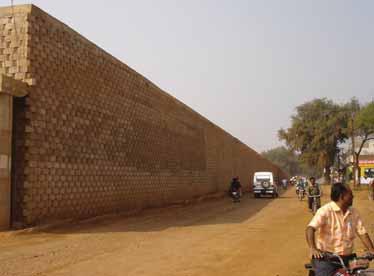
Ashok Bhawnani
With the Indian government committed to building a 6,000-mile interstate highway system, entrepreneur Ashok Bhawnani identified a growth opportunity in his native land. This massive construction program would surely require sophisticated geogrid products to stabilize India’s soils in a great variety of applications.
So, as any good 21st century entrepreneur would do, he turned to Google to research a potential business partner. His search turned up Strata Systems, a Glen Raven subsidiary and an international leader in geogrid technology with a history of international operations. Bhawnani sent an e-mail to introduce himself to Chip Fuller, Strata president.
“Ashok had been active in the fiber and textile industry in India, and I was intrigued by the opportunity,” Fuller said. “I had done some work over the years with geogrid products in India so I was familiar with the market.”
Additional e-mails were exchanged, followed by telephone calls, followed by a visit to the U.S. After each partner thoroughly vetted the other, a partnership was formed, Strata Geosystems (India) Pvt. Ltd., with a goal of supporting India’s long-term road building program.
“Chip and I hit it off immediately,” Bhawnani said. “I wanted to enter technical fabrics, and Strata was interested in a long-term presence in India. Therein lay the convergence of interests, and we haven’t looked back since.”
Strata’s operation in India has followed a two-phased approach. During the first phase, Strata recruited a sales, marketing and engineering team, and Strata geogrid products were manufactured in the U.S. and shipped to India.
Phase II, which began this fall, has included the start-up of manufacturing in India. There is a design, sales and business office in Mumbai, the financial capital of India, and a manufacturing facility in Daman, which is about 125 miles north of Mumbai. The factory houses a warp knitter, beaming equipment and a coating operation occupying approximately 12,000 square feet. An additional 25,000 square feet is available for storage and future expansion.
“Shipping from the U.S. during the initial phases made sense to get us started in India,” Fuller said. “Longer term, we had to have a facility in India, which is extremely advantageous in terms of product availability and lower shipping costs.”
Fuller and Bhawnani are both enthusiastic about the long-term potential for Strata India.
“The growth potential in India, as everyone knows, is huge,” said Bhawnani, a Chartered Accountant (equivalent to CPA.)
“The infrastructure here is underdeveloped, but is on the government’s radar screen for roads, ports, airports, townships and the overall upliftment of the population. Strata’s product range has carved out a niche for itself in this market, and we are optimistic of a demand boom. At this time, we are in take-off mode.”
Strata has a long history of international operations, first moving into global markets in 1997. Fuller and his team are familiar with the challenges and the opportunities for geogrid technology worldwide.
“We are definitely an internationally focused organization, which makes us right for India,” Fuller said. “We understand the logistics, paperwork and container shipping. Our first international distributor was set up in Austria in 1997 and that is when I began traveling the world.”
Strata currently has distributors in, Ireland, Italy, the United Kingdom, Scotland, Israel, Egypt, Algeria, Brunei, India, Australia, New Zealand, Central America and Mexico. Growth through international expansion continues as a major priority for Strata.
While Mumbai, India and Cumming, Georgia, Strata’s headquarters city, are thousands of miles and 24 hours apart, Fuller and Bhawnani are not hampered by the separation.
“The distance is not an issue or a challenge at all,” Bhawnani said. “Language is not an issue and the 24 hours it takes to reach Georgia is not a factor. Some parts of India can take you 24 hours or longer to reach. It is a flat world today. My children are going to schools in Wallingford, Connecticut; Bloomington, Indiana; and, potentially, Pittsburgh, Pennsylvania.”
The terrain in India places Strata products in high demand. Geography is extremely varied, much like the U.S., ranging from desserts and mountains to flat plains. Much of the country is hot and humid, and the miles of railroad track, inherited from the British occupation more than a century ago, create the need for flyovers, which are known as overpasses in the U.S.
“Flyovers require compacted soil and retaining walls that start at two feet and rise as high as 40 feet or more,” Fuller said. “These retaining walls require soil stabilization, and our products fit the need perfectly.”
From Bhawnani’s perspective the partnership with Strata and Glen Raven is based on shared values.
“Any partnership works on the foundation of integrity, dedication, understanding and acceptance,” Bhawnani said. “Strata India will one day be the envy of corporate India –very similar to the status that Glen Raven enjoys in the U.S.”





